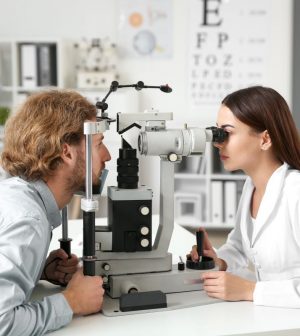- Skip Storing This Everyday Product in the Fridge Door
- Green Tea + B3 Pairing May Boost Brain Health
- Navigating Your Midlife Crisis: Embracing New Possibilities
- City Raccoons Showing Signs of Domestication
- Mapping the Exposome: Science Broadens Focus to Environmental Disease Triggers
- One Week Less on Social Media Linked to Better Mental Health
- Your Brain Changes in Stages as You Age, Study Finds
- Some Suicide Victims Show No Typical Warning Signs, Study Finds
- ByHeart Formula Faces Lawsuits After Babies Sickened With Botulism
- Switch to Vegan Diet Could Cut Your Greenhouse Gas Emissions in Half
Need a Low-Cost Eye Exam, Glasses? The State You Live In Is Key

When it comes to Medicaid and vision care, how much coverage people get depends on the state in which they live, a new study finds.
Most Medicaid enrollees have at least some routine vision coverage, but an estimated 6.5 million adults live in states without comprehensive coverage for routine eye exams, researchers found. Likewise, about 14.6 million adults didn’t have comprehensive coverage for glasses.
In all, 20 states do not cover glasses and 35 states do not cover low vision aids.
That means even if a person’s eye exam is covered, they often can’t afford the glasses they need to correct their vision, the researchers noted.
Medicaid provides health coverage to low-income people and families, and its policies can greatly influence access to vision care.
“The positive finding from our study is that most fee-for-service Medicaid programs across the states covered routine eye exams, which are vital for detecting and addressing vision issues early,” said lead researcher Brandy Lipton, an associate professor of health, society and behavior at the University of California, Irvine (UCI).
“However, the substantial gaps highlight opportunities for policy changes to enhance coverage and access,” Lipton added in a UCI news release. “Providing comprehensive vision care could have big benefits in terms of health, quality of life and even employment and productivity.”
About two-thirds of states with routine vision exam coverage require enrollees to share the cost of the visit, researchers noted. Cost-sharing can potentially deter the poor from seeking necessary eye care.
More than 12 million U.S. adults aged 40 and older have some vision impairment, and that number is projected to double by 2050, researchers said in background notes.
The findings were published recently in the journal Health Affairs.
More information
The U.S. Centers for Disease Control and Prevention has more on the importance of eye exams.
SOURCE: University of California, Irvine, news release, Aug. 12, 2024
Source: HealthDay
Copyright © 2025 HealthDay. All rights reserved.










